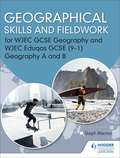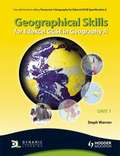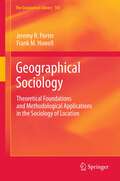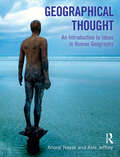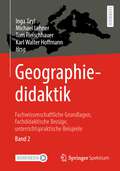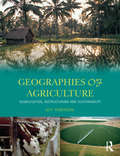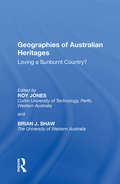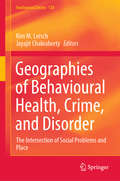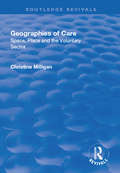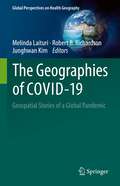- Table View
- List View
Geographical Skills and Fieldwork for WJEC GCSE Geography and WJEC Eduqas GCSE (9–1) Geography A and B (PDF)
by Steph WarrenExam Board: WJEC Level: GCSE Subject: Geography First Teaching: September 2016 First Exam: June 2018 Maximise every student's performance with a step-by-step approach to learning, improving and applying the geographical and fieldwork skills they need to achieve their best under the reformed WJEC/Eduqas GCSE Geography specifications. - Provides a complete, tailor-made solution to teaching the cartographic, graphical, numerical and statistical skills emphasised in the 2016 WJEC Eduqas A and B GCSE Geography specifications - Helps you prepare students for the changed fieldwork assessments and new question formats with a dedicated section on geographical enquiries - Supports students of varying abilities by moving from clear explanations of each skill to easy-to-follow guidance on applying the skills in an examination context - Offers plenty of opportunities to put newly-acquired skills into practice through a range of activities for all learners, as well as extension tasks designed for students targeting the top grades - Boosts students' confidence tackling terminal assessment with skills-focused exam-style questions and insider tips on common question types and topics - Cuts down your marking time and enables students to monitor their own progress by including answers for every activity and exam-style question
Geographical Skills for Edexcel GCSE in Geography A (Unit 1) (PDF)
by Steph WarrenGives students the skills they need for exam success in the compulsory component of Unit 1. Helps students to cover all the geographical skills - cartographic, graphical, ICT and GIS skills including OS map work at 1:50000 - and shows you how to use and apply them.
Geographical Sociology: Theoretical Foundations and Methodological Applications in the Sociology of Location (GeoJournal Library #105)
by Jeremy R. Porter Frank M. HowellThe discipline of Sociology has a rich history of including spatial context in the analysis of social issues. Much of this history has revolved around the development and application of spatial theory aimed at understanding the geographic distribution of social problems, the organization of communities, and the relationship between society and the environment. More recently, the social sciences have seen a large number of technological innovations that now make it possible to place social behaviour in spatial context. Consequently, because of the historical disjuncture in the development of spatial theory and the recent development of relevant methodological tools, the relationship between materials describing both the methodological approaches and their theoretical importance a scattered throughout various books and articles. Geographical Sociology consolidates these materials into a single accessible source in which spatial concepts such as containment, proximity, adjacency, and others are examined in relation to such methodological tools as hierarchical linear models, point pattern analysis, and spatial regression. As these methods continue to increase in popularity among social scientists the ability to more generally understand societies relationship to geographic space will continue to increase in it importance in the field. This book represents a starting point to linking these concepts to practice and is presented in an accessible form in which students, researchers, and educators can all learn, and in turn, contribute to its development.
Geographical Thought: An Introduction To Ideas In Human Geography
by Anoop Nayak Alex JeffreyGeographical Thought provides a clear and accessible introduction to the key ideas and figures in human geography. The book provides an essential introduction to the theories that have shaped the study of societies and space. Opening with an exploration of the founding concepts of human geography in the nineteenth century academy, the authors examine the range of theoretical perspectives that have emerged within human geography over the last century from feminist and marxist scholarship, through to post-colonial and non-representational theories. Each chapter contains insightful lines of argument that encourage readers towards independent thinking and critical evaluation. Supporting materials include a glossary, visual images, further reading suggestions and dialogue boxes.
Geographical Thought: An Introduction to Ideas in Human Geography
by Anoop Nayak Alex JeffreyGeographical Thought provides a clear and accessible introduction to the key ideas and figures in human geography. The book provides an essential introduction to the theories that have shaped the study of societies and space. Opening with an exploration of the founding concepts of human geography in the nineteenth century academy, the authors examine the range of theoretical perspectives that have emerged within human geography over the last century from feminist and marxist scholarship, through to post-colonial and non-representational theories. Each chapter contains insightful lines of argument that encourage readers towards independent thinking and critical evaluation. Supporting materials include a glossary, visual images, further reading suggestions and dialogue boxes.
Geographical Thought: An Introduction to Ideas in Human Geography
by Anoop Nayak Alex JeffreyGeographical Thought provides a clear and accessible introduction to the key ideas and figures in human geography. The book provides an essential introduction to the theories that have shaped the study of societies and space. Opening with an exploration of the founding concepts of human geography in the nineteenth century academy, the authors examine the range of theoretical perspectives that have emerged within human geography over the last century from feminist and marxist scholarship, through to post-colonial and non-representational theories. Each chapter contains insightful lines of argument that encourage readers towards independent thinking and critical evaluation. Supporting materials include a glossary, visual images, further reading suggestions and dialogue boxes.
Geographically Weighted Regression: The Analysis of Spatially Varying Relationships
by A. Stewart Fotheringham Chris Brunsdon Martin CharltonGeographical Weighted Regression (GWR) is a new local modellingtechnique for analysing spatial analysis. This technique allowslocal as opposed to global models of relationships to be measuredand mapped. This is the first and only book on this technique,offering comprehensive coverage on this new 'hot' topic in spatialanalysis. * Provides step-by-step examples of how to use the GWR model usingdata sets and examples on issues such as house price determinants,educational attainment levels and school performance statistics * Contains a broad discussion of and basic concepts on GWR throughto ideas on statistical inference for GWR models * uniquely features accompanying author-written software thatallows users to undertake sophisticated and complex forms of GWRwithin a user-friendly, Windows-based, front-end (see book fordetails).
Geographie und Fernerkundung: Eine Einführung in die geographische Interpretation von Luftbildern und modernen Fernerkundungsdaten (XStudienskripten zur Soziologie)
by Ernst LöfflerAls ich kurz nach meiner Rückkehr aus Australien von dem Mitherausgeber dieser Studienbuchreihe E. Wirth gefragt wurde, ob ich bereit sei, ein kurzes, einführendes Studienbuch zur geographischen Fernerkundung zu schreiben, war meine erste Reaktion negativ. Wozu noch ein neues Buch über Fernerkundung? Es gibt bereits eine Vielzahl ausgezeichneter Handbücher und Einführungen über dieses Gebiet (siehe Literaturverzeichnis), allerdings hauptsächlich in englischer Sprache. Außer dem erschien 1983 das nahezu 2500-seitige Manual of Remote Sensing (COLWELL 1983), das unter der Mitarbeit von über 200 namhaften Wissenschaftlern erstellt wurde und mit Tausenden von Literaturangaben und zahlreichen Illustrationen und Bildbeispielen ausgestattet ist. Auch die als Einführungen gedachten, allerdings oft sehr anspruchsvollen Handbücher von LILLESAND und KIEFER 1979, BARRETI und CURTIS 1982, SCHANDA 1976, TOWNSHEND 1981, SABINS 1978, VERSTAPPEN 1977, SCHNEIDER 1974, LINTZ und SIMONETT 1976, um nur die wichtigsten zu nennen, schienen mir die Notwendigkeit eines weiteren Buches zu erübrigen. Dennoch sagte ich schließlich zu, nicht nur wegen der Überredungskunst meines Kollegen Wirth, sondern weil ich zu der Überzeugung gelangte, daß im deutschspra chigen Raum ein zusammenfassendes, einführendes Buch, welches sich hauptsäch lich an den Studenten wendet und daher weder zu teuer, noch zu technisch, noch zu ausführlich ist und das sich schwerpunktmäßig auf die geographische Anwendung der Fernerkundung konzentriert, immer noch fehlt.
Geographie und Geschichte im Verkehrs- und Siedlungswesen Nordamerikas
by NA BlumDieser Buchtitel ist Teil des Digitalisierungsprojekts Springer Book Archives mit Publikationen, die seit den Anfängen des Verlags von 1842 erschienen sind. Der Verlag stellt mit diesem Archiv Quellen für die historische wie auch die disziplingeschichtliche Forschung zur Verfügung, die jeweils im historischen Kontext betrachtet werden müssen. Dieser Titel erschien in der Zeit vor 1945 und wird daher in seiner zeittypischen politisch-ideologischen Ausrichtung vom Verlag nicht beworben.
Geographiedidaktik: Fachwissenschaftliche Grundlagen, fachdidaktische Bezüge, unterrichtspraktische Beispiele - Band 2
by Inga Gryl Michael Lehner Tom Fleischhauer Karl Walter HoffmannMit dem zweibändigen Werk liegt das erste deutschsprachige Lehrbuch zur Geographiedidaktik vor, welches konkret zum kreativen und praxistauglichen Verknüpfen von fachwissenschaftlichen und fachdidaktischen Bezügen anregt. Mit Hilfe eines „Didaktischen Mischpults“ sollen mannigfaltige didaktische Variations- und Kombinationsmöglichkeiten gelingen. Hierfür stehen neben dem klassischen Inhaltsverzeichnis fünf weitere Verzeichnisse zur Verfügung, die einen einfachen Zugriff auf die einzelnen Abschnitte der jeweiligen Beiträge (geographiedidaktische Bezüge, fachwissenschaftliche Bezüge, Basiskonzepte, Kompetenzen, räumliche Bezüge) ermöglichen und somit ein eigenständiges (Re-)Mixen erleichtern. Außerdem stehen zu vielen Beiträgen konkrete Arbeitsmaterialien und editierbare Druckvorlagen in einem digitalen Materialanhang bereit.Die Gesamtkonzeption des Werks betont die Interdisziplinarität des Fachs Geographie im Bezug zu Natur- und Gesellschaftswissenschaften und stellt die Verflechtung beider Bereiche als Normalfall dar. Mit Blick auf die fachwissenschaftlichen Bezugspunkte und die Orientierung in Lehrplänen werden in Band 1 naturwissenschaftliche und in Band 2 gesellschaftswissenschaftliche zentrierte Anwendungsbezüge dargestellt, aber stets mit interdisziplinären Bezügen im Bereich Mensch-Umwelt-System, da vor dem Hintergrund von Vernetzung und Komplexität keine scharfe Trennung möglich und sinnvoll ist. Beide Bände beinhalten zudem methodische Themen, die im Band 1 die technischen Grundlagen und im Band 2 die sozialgeographischen Implikationen in einer Kultur der Digitalität fokussieren.Die beiden Bände sind ein umfassendes Gemeinschaftswerk, das verschiedene Professionen und Expertisen vereint. Die 83 Autor*innen aus der gesamten deutschsprachigen Community der Geographiedidaktik sind in Schulpraxis, Lehramtsausbildung und/oder fachdidaktischer Forschung tätig. Leitend ist dabei eine theoretisch und empirisch fundierte, reflektierte Praxis. Damit richtet sich das Werk an Schulpraktiker*innen, Lehrer*innen, Referendar*innen, Studierende, Fachdidaktiker*innen, Lehramtsbildner*innen, Theoretiker*innen und Interessierte.
Geographiedidaktik: Fachwissenschaftliche Grundlagen, fachdidaktische Bezüge, unterrichtspraktische Beispiele - Band 1
by Inga Gryl Michael Lehner Tom Fleischhauer Karl Walter HoffmannMit dem zweibändigen Werk liegt das erste deutschsprachige Lehrbuch zur Geographiedidaktik vor, welches konkret zum kreativen und praxistauglichen Verknüpfen von fachwissenschaftlichen und fachdidaktischen Bezügen anregt. Mit Hilfe eines „Didaktischen Mischpults“ sollen mannigfaltige didaktische Variations- und Kombinationsmöglichkeiten gelingen. Hierfür stehen neben dem klassischen Inhaltsverzeichnis fünf weitere Verzeichnisse zur Verfügung, die einen einfachen Zugriff auf die einzelnen Abschnitte der jeweiligen Beiträge (geographiedidaktische Bezüge, fachwissenschaftliche Bezüge, Basiskonzepte, Kompetenzen, räumliche Bezüge) ermöglichen und somit ein eigenständiges (Re-)Mixen erleichtern. Außerdem stehen zu vielen Beiträgen konkrete Arbeitsmaterialien und editierbare Druckvorlagen in einem digitalen Materialanhang bereit. Die Gesamtkonzeption des Werks betont die Interdisziplinarität des Fachs Geographie im Bezug zu Natur- und Gesellschaftswissenschaften und stellt die Verflechtung beider Bereiche als Normalfall dar. Mit Blick auf die fachwissenschaftlichen Bezugspunkte und die Orientierung in Lehrplänen werden in Band 1 naturwissenschaftliche und in Band 2 gesellschaftswissenschaftliche zentrierte Anwendungsbezüge dargestellt, aber stets mit interdisziplinären Bezügen im Bereich Mensch-Umwelt-System, da vor dem Hintergrund von Vernetzung und Komplexität keine scharfe Trennung möglich und sinnvoll ist. Beide Bände beinhalten zudem methodische Themen, die im Band 1 die technischen Grundlagen und im Band 2 die sozialgeographischen Implikationen in einer Kultur der Digitalität fokussieren. Die beiden Bände sind ein umfassendes Gemeinschaftswerk, das verschiedene Professionen und Expertisen vereint. Die 83 Autor*innen aus der gesamten deutschsprachigen Community der Geographiedidaktik sind in Schulpraxis, Lehramtsausbildung und/oder fachdidaktischer Forschung tätig. Leitend ist dabei eine theoretisch und empirisch fundierte, reflektierte Praxis. Damit richtet sich das Werk an Schulpraktiker*innen, Lehrer*innen, Referendar*innen, Studierende, Fachdidaktiker*innen, Lehramtsbildner*innen, Theoretiker*innen und Interessierte.
Geographies of Agriculture: Globalisation, Restructuring and Sustainability
by Guy RobinsonFirst published in 2003. Routledge is an imprint of Taylor & Francis, an informa company.
Geographies of Agriculture: Globalisation, Restructuring and Sustainability
by Guy RobinsonFirst published in 2003. Routledge is an imprint of Taylor & Francis, an informa company.
Geographies of Anticolonialism: Political Networks Across and Beyond South India, c. 1900-1930 (RGS-IBG Book Series)
by Andrew DaviesA fresh approach to scholarship on the diverse nature of Indian anticolonial processes. Brings together a varied selection of literature to explore Indian anticolonialism in new ways Offers a different perspective to geographers seeking to understand political resistance to colonialism Addresses contemporary studies that argue nationalism was joined by other political processes, such as revolutionary and anarchist ideologies, to shape the Indian independence movement Includes a focus on a specific anticolonial group, the “Pondicherry Gang,” and investigates their significant impact which went beyond South India Helps readers understand the diverse nature of anticolonialism, which in turn prompts thinking about the various geographies produced through anticolonial activity
Geographies of Anticolonialism: Political Networks Across and Beyond South India, c. 1900-1930 (RGS-IBG Book Series)
by Andrew DaviesA fresh approach to scholarship on the diverse nature of Indian anticolonial processes. Brings together a varied selection of literature to explore Indian anticolonialism in new ways Offers a different perspective to geographers seeking to understand political resistance to colonialism Addresses contemporary studies that argue nationalism was joined by other political processes, such as revolutionary and anarchist ideologies, to shape the Indian independence movement Includes a focus on a specific anticolonial group, the “Pondicherry Gang,” and investigates their significant impact which went beyond South India Helps readers understand the diverse nature of anticolonialism, which in turn prompts thinking about the various geographies produced through anticolonial activity
Geographies of Australian Heritages: Loving a Sunburnt Country?
by Roy Jones Brian J. ShawIn any settler and/or postcolonial society, heritage is a complex and contested topic that involves indigenous, imperial and other migrant components. In Australia, this situation is compounded by the unique characteristics of the country's natural environment, the considerable diversity of its migrant intake and the demographic and technological imbalances between its indigenous and settler populations. This volume brings together internationally recognized academics and emerging scholars, whose expertise extends through the areas of tourism, planning, heritage management, environmental studies and state and local government. Through a representative set of case studies from across the country's states and capital cities, the contributors demonstrate the range and diversity of heritage issues currently confronting Australia, and consider possible ways of resolving these.
Geographies of Australian Heritages: Loving a Sunburnt Country?
by Roy Jones Brian J. ShawIn any settler and/or postcolonial society, heritage is a complex and contested topic that involves indigenous, imperial and other migrant components. In Australia, this situation is compounded by the unique characteristics of the country's natural environment, the considerable diversity of its migrant intake and the demographic and technological imbalances between its indigenous and settler populations. This volume brings together internationally recognized academics and emerging scholars, whose expertise extends through the areas of tourism, planning, heritage management, environmental studies and state and local government. Through a representative set of case studies from across the country's states and capital cities, the contributors demonstrate the range and diversity of heritage issues currently confronting Australia, and consider possible ways of resolving these.
Geographies of Behavioural Health, Crime, and Disorder: The Intersection of Social Problems and Place (GeoJournal Library #126)
by Jayajit Chakraborty Kim M. LerschThis book focuses on the intersection of place and overall community health thereby focusing on some of the most critical contemporary social problems, including the opioid crisis, suicide, socioeconomic status and ethnicity, mental illness, crime, homelessness, green criminology, and social and environmental justice. Scholars from a variety of disciplines, including geography, sociology, criminology, mental health, social work, and behavioural sciences discuss the importance of geography in our quality of life. Each chapter introduces the reader to an overview of the topic, presents theoretical frameworks and the most recent empirical evidence, and discusses real world policy implications. As such this book is a key resource for researchers, policy makers, and practitioners working in the field.
Geographies of British Modernity: Space and Society in the Twentieth Century (RGS-IBG Book Series #81)
by David Gilbert David Matless Brian ShortThis volume brings together leading scholars in the geography and history of twentieth-century Britain to illustrate the contribution that geographical thinking can make to understanding modern Britain. The first collection to explore the contribution that geographical thinking can make to our understanding of modern Britain. Contains thirteen essays by leading scholars in the geography and history of twentieth-century Britain. Focuses on how and why geographies of Britain have formed and changed over the past century. Combines economic, political, social and cultural geographies. Demonstrates the vitality of work in this field and its relevance to everyday life.
Geographies of British Modernity: Space and Society in the Twentieth Century (RGS-IBG Book Series #48)
by David Gilbert David Matless Brian ShortThis volume brings together leading scholars in the geography and history of twentieth-century Britain to illustrate the contribution that geographical thinking can make to understanding modern Britain. The first collection to explore the contribution that geographical thinking can make to our understanding of modern Britain. Contains thirteen essays by leading scholars in the geography and history of twentieth-century Britain. Focuses on how and why geographies of Britain have formed and changed over the past century. Combines economic, political, social and cultural geographies. Demonstrates the vitality of work in this field and its relevance to everyday life.
Geographies of Care: Space, Place and the Voluntary Sector (Routledge Revivals)
by Christine MilliganThis title was first published in 2001. As care services in Britain have moved from institutional to community-based environments, there has been a simultaneous shift in those agencies concerned with the provision of such care and support. this new environment of care is a complex one, involving numerous different actors and agencies that operate across various different spatial and organizational levels of the policy process. The implementation and success of care policies depend in part on the inter-relationships between these various players. This book examines these inter-relationships, illustrated by an in-depth empirical study of policy makers and informal care providers concerned with the frail elderly in Scotland. Taking the voluntary sector as a lens through which these inter-relationships are explored, it analyzes how voluntary support is affected by differing local contexts of care and what this means in terms of locally based care outcomes.
Geographies of Care: Space, Place and the Voluntary Sector (Routledge Revivals)
by Christine MilliganThis title was first published in 2001. As care services in Britain have moved from institutional to community-based environments, there has been a simultaneous shift in those agencies concerned with the provision of such care and support. this new environment of care is a complex one, involving numerous different actors and agencies that operate across various different spatial and organizational levels of the policy process. The implementation and success of care policies depend in part on the inter-relationships between these various players. This book examines these inter-relationships, illustrated by an in-depth empirical study of policy makers and informal care providers concerned with the frail elderly in Scotland. Taking the voluntary sector as a lens through which these inter-relationships are explored, it analyzes how voluntary support is affected by differing local contexts of care and what this means in terms of locally based care outcomes.
Geographies of Consumption
by Juliana MansveltThis critical introduction to consumption and its geographies provides an engaged summary of the consumption literature and demonstrates that consumption is intimately related to the production of space in everyday life. In Geographies of Consumption Juliana Mansvelt provides readers with a detailed explanation of political-economic and social-cultural perspectives on consumption at different scales. She opens with overview chapters on the history and conceptualisation of consumption and moves on to thematic chapters on consumption spaces; the body and identity; commodity chains; globalization commercial cultures. The text is illustrated throughout with comparative case study-material and features boxes and annotated notes for further reading. A review of consumption from a spatial perspective, this critical analysis of the key debates is the first synoptic overview in the geographic literature. Geographies of Consumption will be widely used in modules in economic and social geography, and should be the core text for those with a focus on consumption
Geographies of Consumption (PDF)
by Juliana MansveltThis critical introduction to consumption and its geographies provides an engaged summary of the consumption literature and demonstrates that consumption is intimately related to the production of space in everyday life. In Geographies of Consumption Juliana Mansvelt provides readers with a detailed explanation of political-economic and social-cultural perspectives on consumption at different scales. She opens with overview chapters on the history and conceptualisation of consumption and moves on to thematic chapters on consumption spaces; the body and identity; commodity chains; globalization commercial cultures. The text is illustrated throughout with comparative case study-material and features boxes and annotated notes for further reading. A review of consumption from a spatial perspective, this critical analysis of the key debates is the first synoptic overview in the geographic literature. Geographies of Consumption will be widely used in modules in economic and social geography, and should be the core text for those with a focus on consumption
The Geographies of COVID-19: Geospatial Stories of a Global Pandemic (Global Perspectives on Health Geography)
by Melinda Laituri Robert B. Richardson Junghwan KimThis volume of case studies focuses on the geographies of COVID-19 around the world. These geographies are located in both time and space concentrating on both first- and second-order impacts of the COVID-19 pandemic. First-order impacts are those associated with the immediate response to the pandemic that include tracking number of deaths and cases, testing, access to hospitals, impacts on essential workers, searching for the origins of the virus and preventive treatments such as vaccines and contact tracing. Second-order impacts are the result of actions, practices, and policies in response to the spread of the virus, with longer-term effects on food security, access to health services, loss of livelihoods, evictions, and migration. Further, the COVID-19 pandemic will be prolonged due to the onset of variants as well as setting the stage for similar future events. This volume provides a synopsis of how geography and geospatial approaches are used to understand this event and the emerging “new normal.” The volume's approach is necessarily selective due to the global reach of the pandemic and the broad sweep of second-order impacts where important issues may be left out. However, the book is envisioned as the prelude to an extended conversation about adaptation to complex circumstances using geospatial tools.Using case studies and examples of geospatial analyses, this volume adopts a geographic lens to highlight the differences and commonalities across space and time where fundamental inequities are exposed, the governmental response is varied, and outcomes remain uncertain. This moment of global collective experience starkly reveals how inequality is ubiquitous and vulnerable populations – those unable to access basic needs – are increasing. This place-based approach identifies how geospatial analyses and resulting maps depict the pandemic as it ebbs and flows across the globe. Data-driven decision making is needed as we navigate the pandemic and determine ways to address future such events to enable local and regional governments in prioritizing limited resources to mitigate the long-term consequences of COVID-19.
